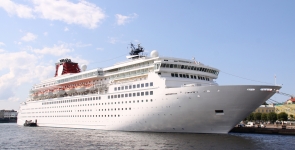CRUISE SHIP INJURIES
Download PDF of this article here

By Michael Panish
Construction Expert Witness
Door & Automatic Door Expert Witness
Architectural Millwork Expert Witness
Most people choosing to take a leisurely vacation on a luxury cruise ship expect everything to be perfect. They are looking forward to beautiful ocean views, hours spent on deck lounging in the sun, and endless food and drink. The idea of many exotic ports of call and a variety of entertaining day excursions are exciting because the cruise ship allows you to stay in one location while your room is transported around the globe. Modern cruise ships are essentially floating city blocks. They include every amenity and utility that makes up a comparative land based location. From the lowest level cargo hold to the highest upper deck, cruise ships have to be looked at with the same attention to maintenance and safety as any hotel or building complex. A marine environment creates an even greater need for routine inspection and maintenance.
It has been my experience as a forensic expert witness that many cruise ships have fallen short on the maintenance and inspection of many elements that are within reach of the general public and passenger guests.
Injuries happen on almost every cruise ship line. I have offered expert opinions in many cases working for plaintiff or defense. All of the different cruise lines have things in common, and the types of injuries are often similar. In general, the staff that is charged with maintenance and observation of specific products or areas where accidents have taken place are often untrained or undertrained for the task. For instance, it is not uncommon to find out that a maintenance man in charge of evaluating automatic doors, never received any training to know how to assess the safe operation of a door system. A former ship steward or bartender are often promoted and used as maintenance workers when a position becomes available. A crew member who may be bored with his position or looking for an increase in monthly salary is looking for another job that offers some change of routine.
Frequently, there is no maintenance of potentially hazardous areas. Crew members have either not been instructed to observe or do not know that they should observe potentially problematic and dangerous equipment or design elements throughout a vessel.
EXAMPLES OF CRUISE SHIP INJURIES
An automatic sliding glass door system was operating without properly functioning sensor interaction. A woman on her way to a buffet was struck and pinned into an adjacent corner when the door repeatedly knocked her down after she attempted to get to her feet. The woman ultimately had a broken leg and pelvis which did not heal properly and has made it impossible for her to walk upstairs to her bedroom, limiting her to live on the lower level of her home since the incident.
A small boy was struck by a steel bulkhead door when a malfunctioning door closer failed to retard the door swing as the ship listed in heavy seas. The bulkhead door was improperly secured by hardware that had become rusted due to lack of ongoing inspection and repair. His arm and shoulder were broken which has created early onset arthritis that may lead to partial mobility in the future.
As a couple was strolling past shops in the center of the main promenade, a glass panel detached and shattered over both of them. It was due to faulty installation of the glass channel, and no observation of any kind was ever documented. The maintenance workers that cleaned the glass had actually seen loose screws and hardware on the floor adjacent to the store window the previous week. Nothing regarding this hardware was ever mentioned to any supervisors or any management. The woman, after being hit by the glass panel, sustained neck and shoulder injuries that later required surgery. The man had glass shards removed from his face and eye.
A man entering a pool deck area was trapped when an automatic doorway failed to open. He was stuck in between sections of a revolving doorway for over an hour. Due to high heat in the compartment, he suffered a stroke. The attending crewmen ultimately broke the glass cylinder surrounding the man to gain access to him once he collapsed on the ground of the doorway compartment. The man was hospitalized and died less than two weeks after the incident.
A small child was injured when a manual door closer caused a door to slam violently. The child had two fingers amputated due to the rapidly closing door. The ship was still docked in a South American port and the child was transported to a local hospital. The fingers were unsuccessfully reattached.
While asleep in his cabin bed, the upper hanging bunk above his bed fell onto a guest. He awoke with wood and metal shards lodged in his arm and torso. He was taken to the ship's doctor and transported to a hospital when the ship reached port several hours later. He developed severe infections due to the poor medical care he received and had to undergo an arm amputation.
Architectural millwork design elements fell onto a couple on a dance floor. Parts of the surrounding décor became dislodged and dropped onto the unsuspecting dancers. Workers had been moving lights and resetting speakers in the disco lounge. They had inadvertently released hanging cables that secured the millwork during their modifications. The man suffered cuts and bruises as well as a concussion. He was later hospitalized and lost partial vision.
Similar cases and claims made as a result of these types of injuries are ongoing and recurring. From a plaintiff's perspective, everyone that is a passenger on a cruise ship should expect to be safe and protected from improperly maintained equipment and deferred conditions. From a defendant's position, passengers have been known to create conditions and behave in ways that are impossible to predict. It is the responsibility of all ship lines to maintain and provide appropriate inspections of all systems of the cruise ship.
In general, the lack of appropriate maintenance by trained personnel has been the genesis of most shipboard injuries. The foreign born crew members are used to a different standard of care when it comes to maintenance on some of these cruise ships. During discovery, some cruise lines attempting to defend their positions have made the statement that they are not required to observe the building codes or ordinances that pertain to the ports where they dock. Many of the ships in use today were built in foreign countries and do not incorporate the same rules and regulations of construction that an American passenger might assume exists.
Having worked for both plaintiff and defendants in these claims, it is important to individually assess each claim as it occurs. Cruise lines should maintain their ships to the highest standards possible. Passengers should pay attention to their surroundings and remain alert no matter what ship or cruise line they have chosen. Often the turnaround time where passengers change between cruises has not been sufficient to make needed repairs prior to the new passengers boarding. Maintenance either cannot be performed or the crew member is now needed for some other job while in port. Regardless of what most cruise lines tell the general public about their ship's workers, the crew members are often treated like indentured servants. They work for their keep, and believe that employment on the ship is a vast improvement from what jobs are available in their native country. The crews are often on board with little or no personal time during the entire time that they are working on the ship. They are busy and often over tired. They rely upon the generosity and tips of the passengers they serve for a substantial portion of their income stream.
Passenger accidents and injuries are a regular occurrence on cruise ships. I am not aware of any verified statistics on the number of injuries vs. the number of passengers that travel. When injuries have occurred, the common response through discovery from the cruise lines is that they have a tremendous volume of passengers every day, and this is the first time they have seen this happen.
As ships continue to increase in size, and the need to entertain becomes more extreme, passengers are being exposed to rides, activities, and architectural design elements that are rarely regulated for safety. There are cruises that offer onboard roller coasters, zip lines, and parachute air tours. If these rides were land based in the United States they would be subjected to strict regulation, regular inspection, and governmental oversight for safety. But, while out at sea, they are not necessarily regulated for safety. A comparison to the level of safety could be the difference between a temporary carnival in a parking lot vs. Disney park rides. Passengers should use extreme caution when pursuing these attractions as their own personal judgment might be the only working safety device that is part of that activity.
Mike Panish has been retained as door expert witness, architectural millwork expert witness, and construction expert witness on many cruise ship door related injury claims and other construction related personal injury claims. He has consulted and offered opinions to maritime defense and plaintiff attorneys as to the site conditions, maintenance, and related service provided by several major independent cruise lines. He has been called to inspect ships domestically and internationally. Mike has worked for both Plaintiff and Defense and has represented several insurance carriers seeking his expertise for maritime claims. Visit www.constructionwitness.com for more information about Mike Panish's expert services and read his many published articles about premises liability and personal injury claims relating to his expertise.



